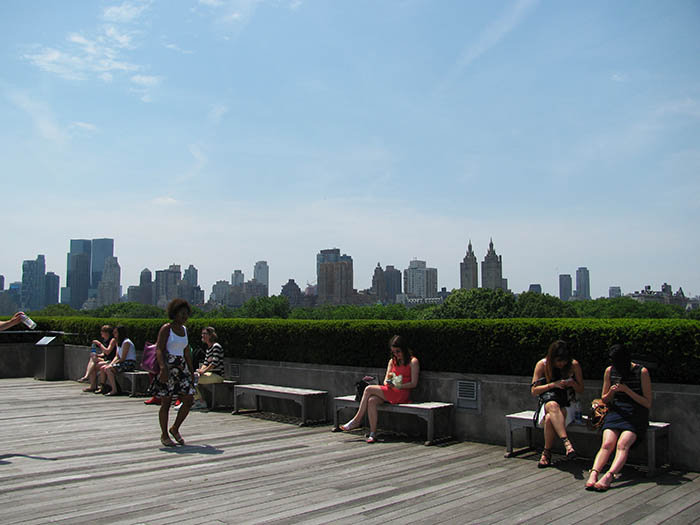아드리안 빌라 로하스 메트뮤지엄 루프가든 2017 프로젝트 작가
The Roof Garden Commission:
Adrián Villar Rojas, The Theater of Disappearance
| Exhibition Dates: | April 14–October 29, 2017 (weather permitting) |
| Exhibition Location: | The Iris and B. Gerald Cantor Roof Garden, Gallery 926 |

Argentinian artist Adrián Villar Rojas has created a site-specific installation for The Met’s Iris and B. Gerald Cantor Roof Garden. The Roof Garden Commission: Adrián Villar Rojas, The Theater of Disappearance will be on view from April 14 through October 29, 2017 (weather permitting). Villar Rojas—known for his large-scale installations—has transformed the Cantor Roof. Sixteen sculptures that fuse human figures with replicas of nearly 100 objects from the Museum’s collection, occupying a new black, white, and gray tiled floor, the installation also encompasses an environmental transformation of the space, including an extension of the existing pergola and new plantings, public furniture, and a newly designed bar.
The exhibition is supported by Bloomberg Philanthropies.
Additional support is provided by Cynthia Hazen Polsky and Leon B. Polsky.
Sheena Wagstaff, Leonard A. Lauder Chairman of Modern and Contemporary Art, said: “This is the fifth year of the Museum’s newly redefined series of Cantor Roof Garden commissions. For his project, Adrián Villar Rojas took on the colossal task of investigating the Museum’s collecting practices from a personal socio-historical viewpoint, laying open his reinterpretation of the collection free of the usual underpinnings of curatorial interpretation and historical reference. In the process, he holds a mirror up to what we do at the Museum, questioning how we elect to present cultural history over time.”
To realize the project, Villar Rojas immersed himself in the Museum’s history and collections, holding conversations with individuals across the institution, including curators, scientific researchers, objects conservators, and imaging specialists. He has also reconciled the Cantor Roof’s many functions as a gallery, a bar, and a popular vantage point from which to view Manhattan’s expansive skyline. The artist integrated these aspects of the space into his installation by working each element—from the floor to the bar—into the conceit of a fantastical event in which white tables are punctuated by black sculptures, all coated in a layer of dust.
In accepting the commission, the artist encountered a history of human culture that emerges from the Museum’s galleries. The Theater of Disappearance presents a story of objects presented without historical interpretation. Using 3D scanning and advanced imaging techniques, the Museum scanned and replicated objects from the collection. In parallel, using the same technology, human figures were also scanned; the models’ bodies and gestures captured as if they were objects. The 3D models were then spliced together with the artifacts to form sculptural amalgamations, resulting in sculptures that absorb and re-present the imagery of Museum objects, being held and touched, unconstrained by demarcations of culture or time. In probing the Museum’s role in framing historical truth, Villar Rojas succeeds in questioning its traditional presentations, allowing for the reactivation and a reinterpretation of art and human culture.
The Roof Garden Commission: Adrián Villar Rojas, The Theater of Disappearance was conceived by Sheena Wagstaff, Leonard A. Lauder Chairman of Modern and Contemporary Art, and curated by Beatrice Galilee, Daniel Brodsky Associate Curator of Architecture and Design, both of The Met’s Department of Modern and Contemporary Art, in consultation with the artist. It is the fifth in a series of site-specific commissions for the outdoor space.
The Roof Garden Commission: Adrián Villar Rojas, The Theater of Disappearance is featured on The Met website, as well as on Facebook, Instagram, and Twitter via the hashtag #CantorRoof.
Related Publication
The exhibition is accompanied by a book published by The Metropolitan Museum of Art and distributed by Yale University Press ($9.95). The introductory essay explores the conceptual framework that informs Villar Rojas’s Roof Garden Commission as well as his interventions around the world. A selection of images the artist took while exploring the Museum is featured alongside commentary by him, offering a unique visual diary of his thought process for the installation.
The catalogue is made possible by the Mary and Louis S. Myers Foundation Endowment Fund.
Cantor Roof Garden Bar
Adrián Villar Rojas collaborated with Restaurant Associates to develop a sustainable menu that offers a selection of sandwiches and snacks made with fresh and local ingredients. Beverage service includes specialty cocktails, wine, beer, soft drinks, and lemonade. The Cantor Roof Garden Bar will operate daily from 11 a.m. until closing, as weather permits. A cocktail bar will also be open on the Cantor Roof Garden’s south deck on Friday and Saturday evenings (3:30–8:00 p.m.).
About the Artist
Adrián Villar Rojas (Rosario, Argentina, born 1980) recent solo exhibitions include: Fantasma, Moderna Museet, Stockholm, Sweden (2015); Rinascimento, Fondazione Sandretto Re Rebaudengo, Torino, Italy (2015); Today We Reboot The Planet, Serpentine Gallery, London (2013); The Evolution of God, Highline, New York (2013); and Poems For Earthlings, SAM ART Projects, Musée du Louvre, Paris (2011).
Major international exhibitions include: the 6th Marrakech Biennale, Marrakech, Morocco (2016); The Most Beautifull of All Mothers, the 14th Istanbul Biennial, Istanbul, Turkey (2015); Storylines: Contemporary Art at the Guggenheim, Solomon R. Guggenheim Museum, New York (2015); and Return the World, Documenta 13, Kassel, Germany (2012).
Villar Rojas has been the recipient of several awards including the Sharjah Biennial Prize, awarded by the Sharjah Art Foundation (SAF) (2015); the Zurich Art Prize at the Museum Haus Konstruktiv (2013); and the 9th Benesse Prize in the 54th Venice Biennial (2011).







